An immigration official announced this past Friday that, in the 42 days between April 19 and May 31, approximately 2,000 immigrant children were removed from the care of their parents and taken into federal custody.
As of Sunday, the number is up to 2342 kids, a number that climbs by approximately 67 kids every day.
At the same time, 11,000 immigrant children are now in shelters, according to the Office of Refugee Resettlement. “Shelters,” however, appears to be a catch-all term for a wide variety of facilities that vary from small, generally child-friendly structures, to a converted Walmart with limited exposure to sunlight, to an old warehouse in South Texas, where hundreds of children wait in a series of temporary cages made of metal chain link fencing.
Over the weekend, a tent city of sorts opened up to hold immigrant kids and adults, also in Texas.
On Sunday, reporters and others were allowed inside the South Texas chain link cage-filled facility, which most people now call Ursula, for the street on which it is located, and what they described was not encouraging.
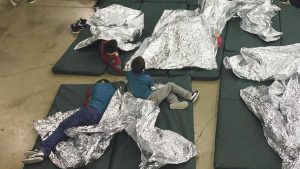
Kids rest in one of the cages at a facility in McAllen, Texas, Sunday, June 17, 2018., photo courtesy of U.S. Customs and Border Protection’s Rio Grande Valley Sector via AP
“A 16-year-old girl was taking care of this child who followed her around asking for her diaper to be changed,” reported Michelle Brané, director of migrant rights at the Women’s Refugee Commission. “No officials “were concerned or cared.” In another instance, Brané tweeted in fury about a cluster of five-year-olds she watched being scolded by stressed officials for playing. Yet there were no visible toys or books or other items that the kids could use to occupy themselves, she added.
As harrowing accounts continued to surface of kids being forcibly separated from their parents, and of unaccompanied minors who surrender to officials at or near the border winding up in detention facilities, physicians began warning about the psychological harm that was being done to these children, and its long-term negative implications.
“[What is occurring] can cause irreparable harm to lifelong development by disrupting a child’s brain architecture,” Colleen Kraft, the president of the American Academy of Pediatrics told BuzzFeed News this week. “Immigration has become so politicized. We would really like people to sit back instead and think of the health of these children.”
It didn’t help Kraft’s outlook when she was persuaded by other very upset physicians to visit a shelter for immigrant children separated from their parents, which was also in South Texas. Kraft told NPR reporter Joel Rose on Morning Edition that she was particularly undone by a little girl she saw at the shelter who could not stop crying.
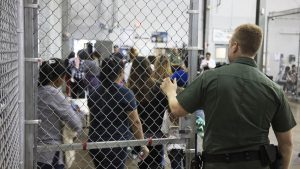
Facility in McAllen, Texas, Sunday, June 17, 2018., photo courtesy of U.S. Customs and Border Protection’s Rio Grande Valley Sector via AP
The girl “couldn’t have been more than 2-years-old,” Kraft said. “Just crying and pounding and having a huge, huge temper tantrum. This child was just screaming, and nobody could help her. And we know why she was crying. She didn’t have her mother. She didn’t have her parent who could soothe her and take care of her.”
Kraft added that staff at the shelter told her regulations did not allow them to touch or hold children to soothe them.
“We know that family separation causes irreparable harm to children,” Kraft wrote in an official statement the AAP released on Friday. “This type of highly stressful experience can disrupt the building of children’s brain architecture. Prolonged exposure to serious stress – known as toxic stress – can lead to lifelong health consequences.”
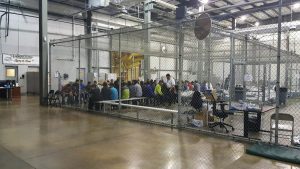
Facility in McAllen, Texas, Sunday, June 17, 2018., photo courtesy of U.S. Customs and Border Protection’s Rio Grande Valley Sector via AP
The day before the AAP statement was released, the American Psychological Association (APA) wrote its own letter to the president using strong terms to convey a similar message.
So, is it true? Is the effect of this kind of trauma for children really that extreme and long-lasting?
The short answer is, yes. It really is.
So what are we talking about when we talk about trauma?
At WitnessLA we’ve been writing off and on about the effect of trauma on kids and adults since our launch in 2007. But here’s a bit of background on the topic that most pertains to the subject at hand.
The easiest place to begin is with what is known as the ACE study.
From 1995 to 1998, a physician and researcher named Dr. Vincent Felitti, who was, at the time, the chief of the Department of Preventive Medicine for Kaiser Permanente in San Diego, together with Dr. Robert Anda from the U.S. Center for Disease Control and Prevention (CDC), conducted an unusual study in which they asked more than 17,421 Kaiser patients about ten categories of childhood trauma, which Felitti and Anda termed adverse childhood experiences or ACEs.
Felitti, whose preventive medicine department had become internationally known for the skill of its medical evaluation center, launched the ACE study after he discovered, somewhat by accident, that several hundred of the patients enrolled in his obesity clinic had been sexually abused as children. Flabbergasted at the high numbers, he decided to explore this trauma/health connection a little further. After hearing of his unusual, but still limited findings, epidemiologist Robert Anda decided to sign on to Felitt’s research plans, bringing the CDC with him.
When WitnessLA spoke to Dr. Felitti years later in 2014, he explained that when he and Anda began the 1995 study, he coined the ACEs term because the term “trauma” has, for obvious reasons, a negative connotation, whereas the term adverse childhood experience sounds more neutral. This meant that research subjects asked about the latter rather than the former, tended to answer questions more easily and honestly.
After analyzing the initial data that resulted, in 1998 Felitti and Anda published their findings, which showed what appeared to be an irrefutable relationship between their subjects’ ACE scores and their physical and emotional health later in life.
After those first findings, Felitti and Anda continued to follow their subjects over subsequent years with periodic updates, and the correlation became even stronger and more specific.
In a 2002 article published in a medical journal, Felitti wrote further about the results of his and Anda’s research for medical professionals.
“The findings are important medically, socially, and economically,” he wrote. “They provide remarkable insight into how we become what we are as individuals and as a nation. The ACE Study reveals a powerful relation between our emotional experiences as children and our adult emotional health, physical health, and major causes of mortality in the United States. Moreover, the time factors in the study make it clear that time does not heal some of the adverse experiences we found… in the childhoods of a large population of middle-aged, middle-class Americans. One doesn’t ‘just get over’ some things.”
Building on the Kaiser ACE study
Although the results of Felitti and Anda’s 1998 study were incredibly dramatic, it took awhile before anyone outside a certain circle of medical professionals and researchers really talked much about the profound implications the ACE study revealed.
Eventually, of course, the Kaiser study became the foundational research from which an entire area of inquiry has developed, along with parallel research that has delved further into why something traumatic that happened to you at age seven could lead to a physical condition forty years later.
(For more details on the development of the Filetti/Anda research see journalist/editor Jane Ellen Stevens’ excellent longread account here.)
Now we know that certain kinds of childhood trauma can trigger chemical reactions that in turn produce long-term changes in a kid’s brain structure, and that high ACE scores can compromise the immune system, produce learning issues, and dramatically increase the likelihood of high-risk behavior, of depression, of suicidality, of later incarceration, and lots more.
These correlations were illustrated strikingly in a California study released in November 2014 by San Francisco’s Center for Youth Wellness, led by Dr. Nadine Burke-Harris.
(Burke-Harris has become a leading voice in the world where childhood trauma and health intersect, and her TED talk is an excellent short course in the issue, if you’ve not ever seen it.)
The CYW study used data from 27,745 surveys conducted by California Behavioral Risk Factor Surveillance System surveys between 2008 and 2013 to show even more detailed correlations.
(The Behavior Risk Factor Surveillance System, which was established in 1984 by the Centers for Disease Control and Prevention, is the nation’s premier system of health-related telephone surveys that collect state data about U.S. residents regarding their health-related risk behaviors.)
The 2014 study found that a Californian with 4 or more ACEs was:
• 5.13 times as likely to suffer from depression
• 2.42 times as likely to have chronic obstructive pulmonary disease (COPD)
• 2.93 times as likely to smoke
• 3.23 times as likely to binge drink
More recent information demonstrating more specific ACEs’ effects emerged from a 2017 UCLA study, published in the American Academy of Pediatrics, which gathered data from 14,344 participants from the National Longitudinal Study of Adolescent to Adult Health, 14% of whom reported being locked up between the ages of 12 and 23. Of those, 50.3% were incarcerated for one month or less, 35% were locked up between one and 12 months, and 15% were incarcerated for a year or more.
The underlying national study that the UCLA team worked with was longitudinal, in that the researchers interviewed their subjects first as adolescents and then a second time between the ages of 24 and 34. From the second round of data, the UCLA researchers learned, for example, that those young people who were incarcerated for up to a month were 41% more likely to experience depression as adults than the study’s participants who had never been incarcerated, among a list of other problems. And those who were locked up between a month and a year were 48% more likely to report worse general health than their non-justice-system-involved peers. This was after researchers had controlled for factors like race, income, parents’ education level and more.
These 2017 findings about the adverse physical and psychological effects produced by just a month of confinement during childhood, of course, have a direct bearing on the difficulties faced by immigrant children whose heart-lacerating stories now appear daily in our news feeds.
The LA County Supes weigh in
With all of the above in mind, the Los Angeles County Board of Supervisors will vote on Tuesday on a motion co-sponsored by Supervisors Hilda Solis and Sheila Kuehl that, if passed, will result in a letter send from the board to the Secretary of the Department of Homeland Security, the Senate and House leadership, and the Los Angeles County Congressional Delegation:
- Opposing the practice of separating children from their families and urging that no funding be approved for the prosecution of parents seeking asylum who arrive at the border with minor children;
- Direct DCFS and the Office of Immigrant Affairs to report to the County Counsel any children who were separated from their parents at the border, who could be in LA County foster care/relative care and, where possible, offer assistance in contacting federal officials so that minors can be released into foster/relative care while their parents are in detention;
- Direct the Office of Immigrant Affairs, in coordination with County Counsel, to contact the U.S. Office of Refugee Resettlement and request permission to visit shelters (operated by the U.S. Department of Health & Human Services) to offer assistance to any minors that could be released into the custody of relatives in Los Angeles County, through the Department of Children and Family Services.
We will, of course, keep you posted on the outcome.

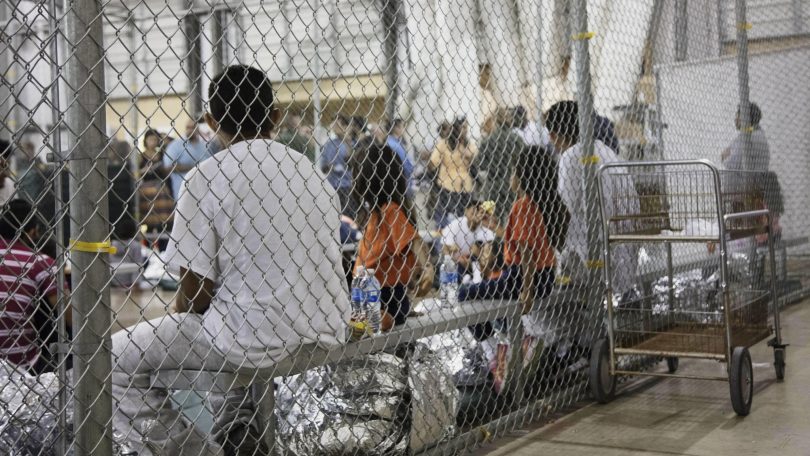
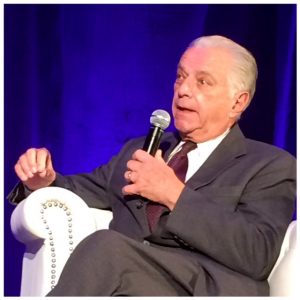
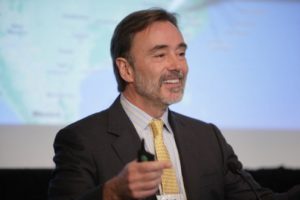
This is the reason why former President Obama should tried for Crimes Against Humanity. The initial pictures of children in cages were taken in 2014. Obama said that anyone who brings children to the border”must turn back.” Obama said “we are a nation of laws.” Obama said that illegal immigrants are not “entitled to services.” Had Obama passed Immigration Reform when he had both houses of congress and a filibuster proof senate, would any of this be happening? No, is the plain answer. Instead Obama admitted that DACA was “likely unconstitutional” but went ahead anyway. Like Ollie said to Stan “this is another fine mess you got us into.”
Currently, we have 70 % of Black children being born with no father around. 58% of Hispanic children and 38% of white children, according to gov records. How about those policies that promote the horror of men abandoning their children here at HOME? Planned Parenthood would rather murder the kids before their born. Asian stats are so low they are not worth reporting, I guess? Shouldn’t we help American born children first? If we look at the current trends isn’t hypocritical, for American Leftist, to complain about illegal immigrants family separation when(if allowed to stay) the father will desert their kids anyway?
Re the separation of families I agree to reunite the families and send them back to their country and then charge the country for the flights. Next, use that money to send church missionaries to those countries to help out. How come atheist seldom help out? Um!
Obama granted himself immunity from prosecution. However, this immunity only applies to American Law. The Hague should investigate and prosecute him to the full extent of the law. No other one person bares the brunt of liability and criminal behavior than Obama.
Let’s ask the bitter question; had former President Obama passed Immigration Reform would President Trump been elected? I have stated many times that (unknowingly) former President Obama made the election of President Trump possible, brick by brick.
Someone might want to let the LA “supes” know that they run a couple of departments who’s missions are pretty much devoted to removing children from parents, and locking children in cages. I mean, half of Witness la’s stories are devoted to these departments, does their hypocrisy know any bounds?
Um, great post.
It’s actually scary what Obama COULD HAVE done. Carter too. Thank God they were two of the most unintelligent people ever to walk into the WH. Charisma and electability are one thing, getting things done is a whole different ballgame.
The sad thing about Obama, is that if he had any experience or intelligence, he could have made the world a better place. When he got elected, I got really excited. Then after running the economy into the ground and dividing us back to the 1950’s, I realized he was one of, if not the worst, POTUS of all time. Sad.
Um, Bingo!
Please explain to me how this is any different than a single parent getting arrested for a crime? Last time I checked the parent can’t take their child with them to prison. Child and parent are separated.
Awesome Um, these liberal social warriors are a bunch of hypocrites, they cherry pick their causes based on their hate and animosity toward certain people who feel differently than they do. There are so many horrors currently happening to the kids of deputies persecuted by the sheriff inquisition, yet, they are silent because in those cases they feel the end justifies the means…hypocrites…
Does anyone in the county care to find out about the kids of the deputies who were framed by the sheriff for political reasons how they are doing? Most likely they are American Citizens….any studies as to whether those deputies’ children were incarcerated with the deputy at the booking cage or were they separated? Any studies as to what the county supervisors did for those deputies’ children?
Joe NoBuckles:
“…the deputies who were framed by the sheriff for political reasons….”
Can you cite a few examples so we, the WLA readership, can follow along as their cases progress through the Civil Service & criminal justice systems?
That way, we can see for ourselves.
Thanks.
I really care for that deputy I have referenced in previous posts, for that reason, I am sure his attorneys would be upset if say stuff here. He was framed, and the court dismissed the case citing, constitutional prejudiced, 6th and 14th. The court also took the rare step of declaring based on what he heard from the witnesses, sheriff experts, there was no physical evidence the deputy committed the crime and theorized the criminal was the complainant, the fine citizen. I would say the criminals were the sheriff’s personnel.
Sooner or later, it will be exposed in the right venue, I would speculate the Federal Court. Rest assured Cognistator, it will be exposed. The court only heard a tiny fraction of all the shenanigans the sheriff people at the bottom and at the top did in trying to put this deputy in state prison.
The sheriff goal was to make this deputy a mentally ill, homeless and convicted criminal. There their hypocrisy of these justice warriors, in one hand they fight for the mentally ill, the homeless, and the criminal. On the other hand, they turn a good citizen, into a mentally ill person, homeless, and a criminal.
Shocking, but what can you expect from these people running the department, no less, no more.
Joe NoBuckles:
“He was framed, and the court dismissed the case….”
O.K.
That means it’s in the Public Domain and thus already Public Knowledge; just give us a name & case# & we’ll do everything else.
O.K?
I guess it is true, it is public domain, public hearing….there you go The People of the State of California v. Pedro Castillo, case No. BA453611, Count one, 502(c)(4) PC, a felony, LA County Jail booking No.4873559.
What happened to the concept of “equal protection and treatment under the law”. If anyone violates the law, is arrested and sent to jail or sentenced to prison, their “family unit” is never left intact. I’ve never heard of individual “family style jails” in any country. Why are certain politicians and the media so quick to advocate “unequal treatment” under the law for one group and not all?
If the law is changed for people who enter under the country illegally, to be fair and equal, shouldn’t it be changed for US citizens to?
Why doesn’t anyone advocate trying to make the countries better so these people won’t want to flee? I don’t hear any of the politicians from any of the country these people are fleeing express concern over the loss of their people. Instead they encourage illegal immigration to the US, help facilitate it and condemn the US for enforcing it’s laws and desire to build a boarder wall.
Separating immigrant children from their parents is a human, bipartisan concern. It has been encouraging to see Laura Bush, Franklin Graham, many other Republicans speaking out along with Democrats to demand that this abusive, highly traumatizing treatment of children and families end immediately.
What about the trauma felt by the families and children in far away lands, trying to immigrate to the US the right way, only to see their space being by taken by someone who “cuts to the front of the line”, violates the law and expects special treatment.
What about their trauma????
[…] Separating Immigrant Kids From Their Parents & What We Know About the High Cost of Childhood Tra… by Celeste Fremon, WitnessLA […]
You should know that most of these “children” were separated from their parents willing by the parents, or kidnapped for human traffic, long before they crossed the border. Most of the children have no parents with them. The separated children are in other words taken into protective custody. Also many of the “children” are 12 to 17 year old (more likely late teen to early twenties) gang members.
There was a reason and a need for this policy.